

Classic Buses Profiles
News and mail page 2 (by Dick Gilbert)
Last updated 4 December 2022
SOME LINKS WITHIN THIS WEBSITE: Home Email Links THE COMPLETE WEBSITE MENU Events Diary Halfcab list Small-Ads Classic Irish Buses Classic Manx Buses
Why not share a story or a nice picture here? To send contributions you can Email me here.
See more archived news items and pictures on Page 1 (latest) or Page 3 (oldest).
RTL STILL WORKING IN SOUTH AFRICA
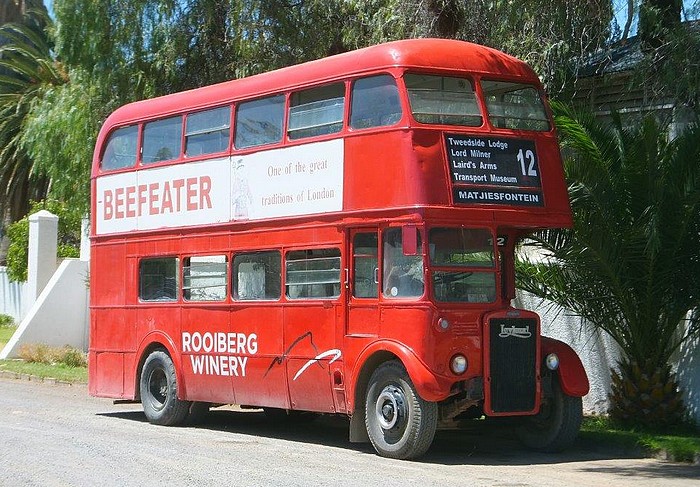
We've come across this bus before, but not for a long time. Alan Kenny, who has been contributing to this website for many years, was on safari in South Africa in January 2016 and spotted this 1950 ex-London Transport Leyland RTL841 (originally registered KYY 811) at the Lord Milner Hotel, Matjiesfontein in the Western Cape province.
It was imported by Cape Electric Tramways in 1966 and worked with them for 10 years, but ended up in Matjiesfontein running tours of the village. Alan says that the last licence expired at the end of October 2000 so presumably it's now only used on private roads. Many thanks to Alan for the picture.
SCENES FROM TROWBRIDGE
In January 2016 Stevie Oswin kindly sent me some pictures from Trowbridge, where his grandfather, Kenneth Down, was foreman from the 1940s until 1978, having worked for Devon General previously. I'd also like to thank Nigel Utting for providing the necessary facts for the captions. Nigel points out that everything suggests the pictures were taken around 1974 after Bristol Omnibus Company had taken over operations at Trowbridge, so all the vehicles shown would be under BOC ownership.
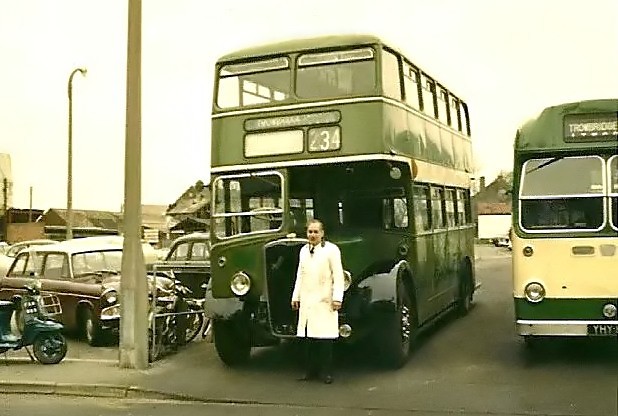
Firstly here is the great man, Kenneth Down in front of a former Western National Bristol KSW6B. Nigel Utting thinks that this is either LTA 843 (W139) or LTA 844 (W137). Both passed from Western National to BOC in 1970 and became driver trainers for a few years, and we assume that's what it's doing here. Nigel has a hunch that this is LTA 844, and I agree because other contemporary pictures show it having the shinier mudguards! Alongside is a Bristol Omnibus LS5G dating from 1957.
Western National (Glos. & Wilts.) was first established in Trowbridge in 1929 with a simple office under the Market House and a leased garage in Bythesea Road which was bought in 1935. The depot was abandoned in 1962 when a new bus station and garage was opened in The Conigre.
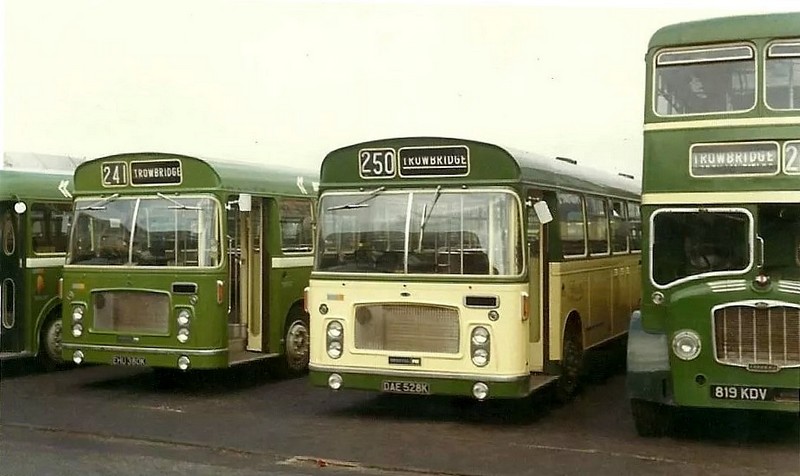
Here's a fine collection of buses at Trowbridge in the 1970s - two Bristol RELLs and a Lodekka. On the left is RELL6L 1279 (EHU 380K), new to Bristol Omnibus in 1972. Based at Trowbridge it was often to be found on Route 241 to Warminster. In the centre is a Bristol Omnibus RESL6L, No.529 (DAE 528K) on Route 250 from Trowbridge to Studley Green. Both REs wear "TE" plates (adopted in 1974) alongside the fleet number, indicating their residence at Trowbridge depot. On the right is 1963 FLF6B Lodekka No.2014 (819 KDV), one of seven which came from Western National in 1970. This one became No.7316 in the Bristol Omnibus fleet.
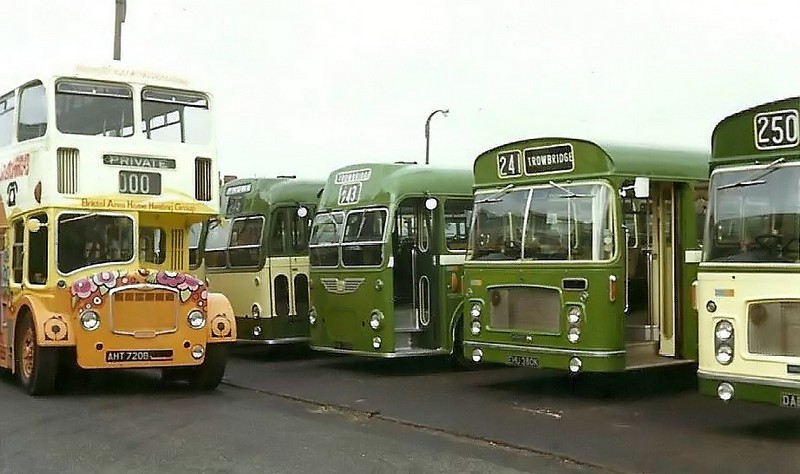
Just turning to the left a bit, we can see the two RELLs shown above on the right. Everything in this picture was new to Bristol Omnibus. In the centre are two MWs. I suspect that the all-green example is one of the 1959 Bristol MW6G buses with xxx DAE registrations delivered in 1959, and the other one (or is that two?) is a 1957 Bristol LS5G with a YHY registration, as seen in the first picture of this article above. And what is the strange thing on the left? More details below.
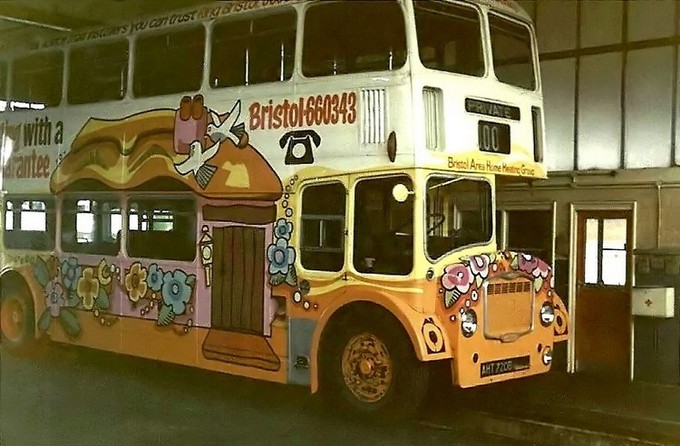
Here is that FLF6B Lodekka, apparently over the pit at Trowbridge. New to Bristol Omnibus in 1964 as No.C7164 (AHT 720B) it is seen in a later life working for the "Bristol Area Home Heating Centre". Nigel explained that this was actually an overall advert on behalf of the Heating and Ventilation Council, a contract which ran from 1/73 until 3/74. All this detail strongly suggests the last three photos were taken in early 1974.
Thanks very much to Stevie for the pictures, and to Nigel for straightening out fact from fiction. He also recommends a visit to David Pike's excellent article about Trowbridge here.
EXETER BUS STATION TO BE REDEVELOPED

Construction of the new Exeter bus station under way in 1963 with a Bedford lorry of a once well-known local haulage contractor, Frank Tucker. (Exeter Express & Echo)
At a packed Exeter Guildhall on 20 January 2016 an extraordinary meeting of Exeter City Council approved controversial £70m plans by Crown Estates for redevelopment of the existing bus and coach station site at Paris Street. In its place will come more retail development, a cinema, a swimming pool and a much smaller bus station. Paris Street will also be closed to through traffic and this will be redirected into neighbouring streets.
For bus and coach users and operators, the decision (under discussion since 1984) is unlikely to be good news. The replacement bus station will be smaller, forcing the use of adjoining streets for certain high frequency bus services operated by Stagecoach South West as will those of National Express coach services. There will no longer be parking facilities for touring coaches and these will be directed to park at an existing coach park away from The city centre and lacking any facilities for drivers.
The first Exeter bus station opened in 1931 near the top of Paul Street, but facilities for passengers were minimal and in 1949 much-needed extra space was created by leasing space in the adjacent car park. Plans for an improved station in Paris Street were prepared by Exeter City Council and work commenced with site clearance in August 1962.
The site sloped from north to south, so a two-level facility was constructed, in which the upper level became the bus station and the lower level the coach station. There were eighteen departure bays, into which buses drove head-on and reversed out, plus parking for two rows of buses alongside the boundary wall. The large covered passenger concourse for included seating, an enquiry office and waiting room, a tours booking office, parcels and left luggage office and a staff canteen. The lower-level coach station could comfortably accommodate 72 coaches and had a waiting room and toilets, an inspectors' room and chart room for monitoring express coach services. There was also a cafeteria and shop, open during normal shop hours, plus vending machines and phone booths.

Devon General vacated Paul Street and commenced leasing the new premises in 1964. In the 1960s, the coach station was a hive of activity in the summer months with the luxury coaches of Greenslades Tours and Grey Cars departing on local and extended tours, the express coach services of Royal Blue, Associated Motorways and Yelloway Motor Services and others, plus visiting coach tours and local services provided by independent coach and bus operators.
In 1972 National Travel (South West) was formed, later to become National Express from 1978. Cross-country services were then axed and the company concentrated on competition with the railways, especially following de-regulation on 6 October 1980. Rapide express coach services started by Trathens of Plymouth flourished and a joint operation was formed between National Express and Trathens with services from Paignton to London and Newcastle-upon-Tyne calling at Exeter.
By 1984, the shortcomings of the coach station and the decline in coach tours led to the movement of express coach services to the upper level (bus station) site from 1 April 1984. By then, services operated from just a couple of bus bays - a sad decline from what was once a very busy coach station, capable of accommodating, at a squeeze, approximately one hundred vehicles. The facility has performed an invaluable role at a convenient location for over 50 years but time moves on and, for better or for worse, it will be closed in 2016 and replaced by a new and more compact facility in Belgrave Road. This will replace the bus garage constructed there in 1975 which is to be relocated to a new site on the city's outskirts.
This information was supplied by the late (and much missed) Philip Platt. Finally here's a great picture from Dave Godley.

This is Exeter Bus and Coach Station as seen during its 50th anniversary event on 5 July 2014. Have a close look at this view and see how many gems you can spot.
Redevelopment was delayed with a revised date for closure set as 28 October 2017, subsequently changed to 17 June 2018. But that will only apply to the lower area, and the upper part of the bus station will remain open for service buses. Coaches can park on the Haven Banks site south of the River Exe.
SOUTHDOWN TENDERS AND TRADE PLATES
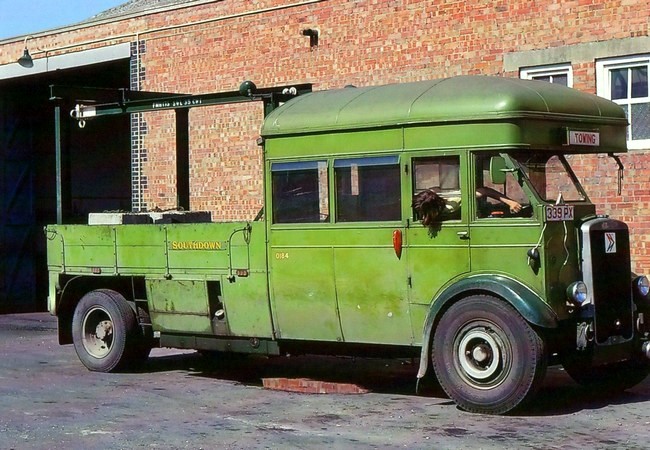
This fine picture taken by Ken Jones at the Southdown 100 event in Southsea in June 2015, shows Southdown breakdown tender 0184 (EUF 184), converted from a 1938 Leyland TD5 bus and now owned by the Southdown Omnibus Trust. It makes a relevant link to a recent addition to this website, Clifford Jones's memories of Southdown, his ownership of one of these tenders, and many other tales. Thanks Ken.
Incidentally Clifford (who knows a thing or two about these breakdown vehicles) has noted that the number plate is in the wrong place. When converted to a recovery vehicle the number plate was relocated under the windscreen where the brackets were for the trade plates. But those brackets now hold a "TOWING" sign which should be up on the cant rail where the holes for those brackets are still visible. The brackets themselves seem to have disappeared.
Having said that, all the Southdown TD5 breakdown trucks did have blank plates below the radiator which bore no number. Presumably the brackets below the windscreen enabled various trade plates to be attached or changed as required. Perhaps, now that the vehicle has reverted to its permanent number EUF 184, the owner has decided to use the fixed plate instead. It's all so complicated...
Clifford has added further information to straighten out my trade plates comments above; "Each depot had a trade plate for their breakdown tender, e.g. my 0181 always carried trade plate 184 CD. The Eastbourne tender had trade plate 067 HC on it as a TD1, and 150 HC as a TD5. This was probably due to Eastbourne requiring more trade plate(s) and they got swapped, but HC is Eastbourne whereas CD on mine was Brighton."
"When 0184 was based at Chichester it would have had 339 PX on it, which was transferred to the AEC Matador when it came to Chichester, as the Chevy was retired at Horsham which had 097 BP on it. The slotted brackets were just in case they were temporarily needed elsewhere or went to another depot. Trade plates were never permanently fixed to a vehicle, as in some cases in the trade they were in rubber mounts to be hung on a vehicle."
"Just to complete the picture, trade plates were originally 'general' or 'restricted'. 184 CD on mine is always photographed with general trade plates, which had a red background and white letters, so they could be used on any vehicle, and it was permitted to carry a load. This was to facilitate the breakdown tenders going to Portslade to pick up engine/gearboxes etc. which was the intention of the gantry system. When general plates were withdrawn, restricted plates - red letters on a white background - could only be used and no load could be carried. Finally the privilege of using them on breakdown tenders was withdrawn and the original number plate had to be put back."
THREE SURVIVORS IN CANADA
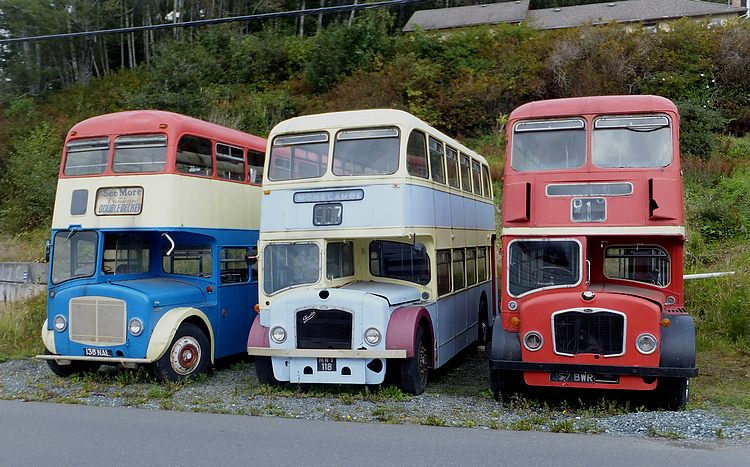
Alan Kenny contacted me in September 2015 as he was travelling in Canada came across these buses in Alert Bay BC, comprising two Bristol Lodekkas MWY 118 and 957 BWR along with AEC Regent V 138 NAL. All were complete with seats, the AEC platform was rotten, MWY 118 had no engine/gearbox. They were rescued from Victoria, where they used to run tours around town; all the others were apparently scrapped. They were parked at the Seine Boat Inn and were owned by the proprietor Colin, who was away when I was there."
138 NAL is a 1962 Regent V No.38 from the fleet of West Bridgford (later Nottingham City Transport), MWY 118 is a 1954 LD6G Lodekka originally West Yorkshire DX9, and 957 BWR was a 1963 Bristol Lodekka FS6B, also from West Yorkshire as their number KDX143.
John Hinson, who knows a lot about classic bus matters, says the buses were part of a collection belonging to Paul Tremblay, under the name of the Charity Plus Society. He said "For years they could be seen from route 4 near the crossing with route 19 near Qualicum Beach, Vancouver Island. In theory, the collection of vehicles constitutes a museum, although many of the vehicles are visibly in poor condition and their long-term future is questionable."
Thanks to Alan for the photo.
'CHICK' PERKINS AND HIS KENT BUSES

John Watler kindly sent me these five photographs, showing driver Walter "Chick" Perkins during his career as a driver in east Kent. John says "The first shows him (second from left) together with his conductor and passengers. Unfortunately I do not know the date, type of bus, or location, however the route board says 'Ramsgate, Sandwich and Ash via Woodensborough, (and I think) Marshborough and New Street'.
My guess is a Ford Model T around 1925-27, but I'm sure someone will tell me more. What is that company name on the side? Could it be SERPENTINE? Probably it's one of the 50 or so firms that were swallowed up by East Kent Road Car before the war.
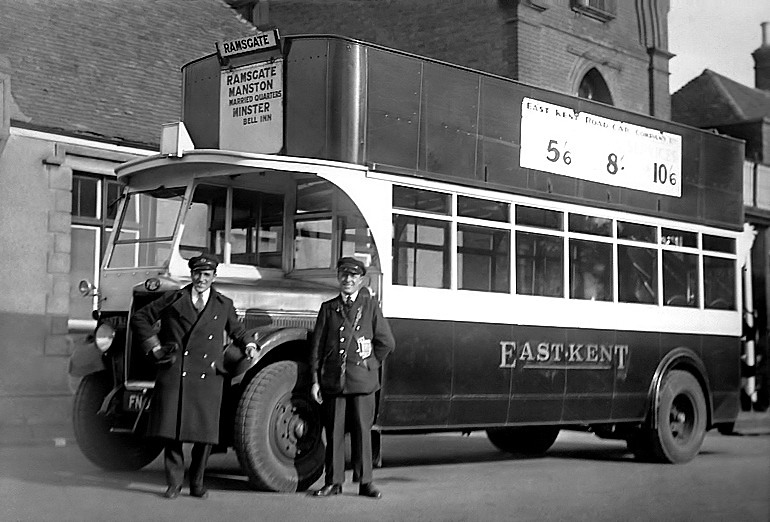
The picture above shows 'Chick' Perkins and his conductor with their open top East Kent Leyland Tiger FN 9544. This (and the picture below) were taken outside the old Molineux Institute building (demolished in the 1970s) at # Minster at some time in the 1930s, with the bus heading for Ramsgate via the RAF base at Manston.
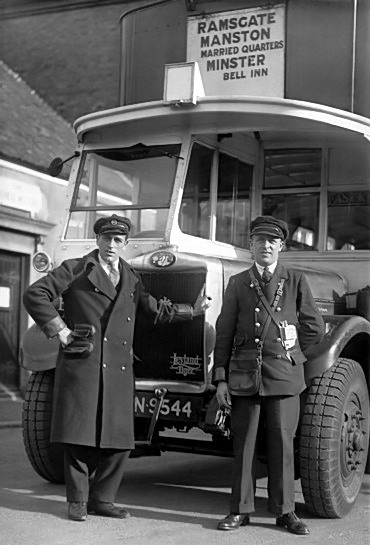
This TS1 was the only Leyland Tiger delivered to East Kent in 1929 and, although the Tiger was normally considered a single-deck vehicle, FN 9544 had this double-deck open-top Short Brothers body from new. It was called up for military service in World War Two and did not return.

This picture shows Perkins (on the right) with another driver in front of 1956 Weymann-bodied dual-purpose AEC Reliance LJG 325, possibly on the same trip as shown in the picture below. There were 22 vehicles in this batch and they remained in service until the early 1970s, with LJG 325 being sold to a dealer in early 1974.

The last image shows five East Kent Reliance coaches (presumably from the LJG batch) with a party of Royal Marines (then based in Deal) in front of Edinburgh Castle, possibly in connection with the Edinburgh Tattoo. 'Chick' Perkins is standing in the doorway of the central bus No 4.
My thanks to John for this interesting set of pictures.
SOUTH WALES TREE LOPPER
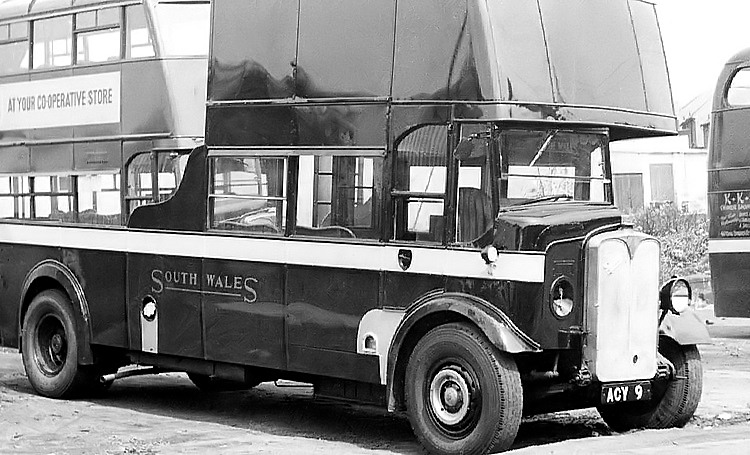
This unusual image was sent by Jules Christian. It shows a South Wales Transport AEC Regent I bus converted in 1952 to a tree-lopper and recovery vehicle. The company was eventually to acquire a remarkable total of 515 Regents, of which 112 were of the Mk.1 model, starting in 1932. This particular example, ACY 9, was No.9 in a batch of fifty delivered at the end of 1936 (1-50, ACY 1-50) with Weymann metal-framed 56-seat bodies.
The design of this smart conversion is presumably to provide tree-lopping capability at the front, and a more general utility space at the rear. It doesn't seem to incorporate a crane, so perhaps the back was more often used as a space for chucking stripped branches. Many thanks to Jules for sending it.
COLIN SHEARS 1934-2015
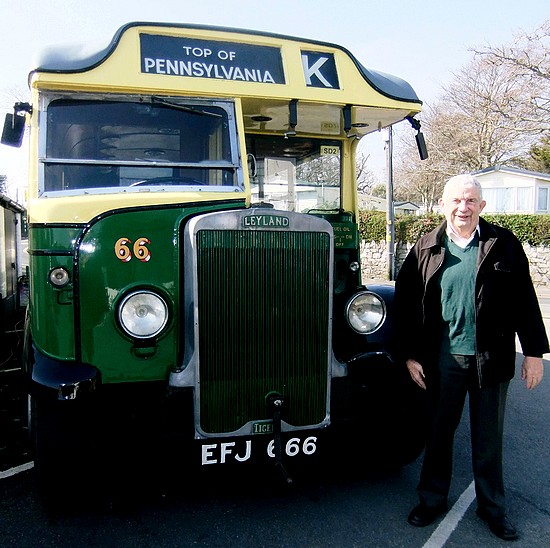
It is with much regret that we report that Colin Shears, the well known and highly regarded enthusiast of old vehicles and the countryside, passed away peacefully on 20 March 2015 at the Royal Devon and Exeter Hospital in Exeter.
Born on 5 March 1934 and brought up in the Pennsylvania area of Exeter, he developed a keen interest in local road transport from a very early age. Even at school, he was drawing buses in his exercise books, much to the puzzlement of his teachers! He was a pioneer in the hobby of preserving old buses and other commercial vehicles, purchasing the first of many as long ago as 1956. Happily, this vehicle and many subsequent ones are still with us today and have brought much pleasure to past and present day generations wherever they have been displayed.
In 1963 Colin succeeded in purchasing a large former aircraft hangar in North Devon. With the help of fellow old vehicle enthusiasts over the past 50+ years this has enabled the rescue of literally hundreds of historic buses, coaches, commercial vehicles and cars. Fortunately, his son Daniel has taken on his interest and he now manages the vehicle collection as well as acquiring his own historic vehicles.
Colin also had a keen interest in other preservation and conservation matters as well as the countryside and particularly his beloved North Devon and Exmoor which he visited frequently ever since as a child when he travelled there with his parents. He was an early member of the Historic Commercial Vehicle Club and the Exeter based Crash Box Car Club and several other preservation and conservation bodies.
In latter years, Colin and his partner Margaret enjoyed numerous trips throughout the U. K. and abroad. These included many on the preserved paddle steamer 'Waverley', especially to his beloved Lundy island. Last year saw the completion and publication by the West Country Historic Omnibus and Transport Trust of his autobiography - a fascinating read!
We extend our condolences to Colin's family and to his partner Margaret on their sad loss of a man who was a pioneer and has left a lasting legacy of the history of road transport in the West Country. His funeral took place on Thursday 9 April at Exeter and Devon Crematorium. For his final journey, Colin was conveyed in his beloved 1938 Leyland Tiger TS8 EFJ 666, which he purchased from Exeter City Transport in 1956. It was driven by his son, Daniel.
(Philip Platt kindly sent this information and forwarded the obituary. Sadly Philip also died the following year.)
A DENNIS FROM THE 1950s
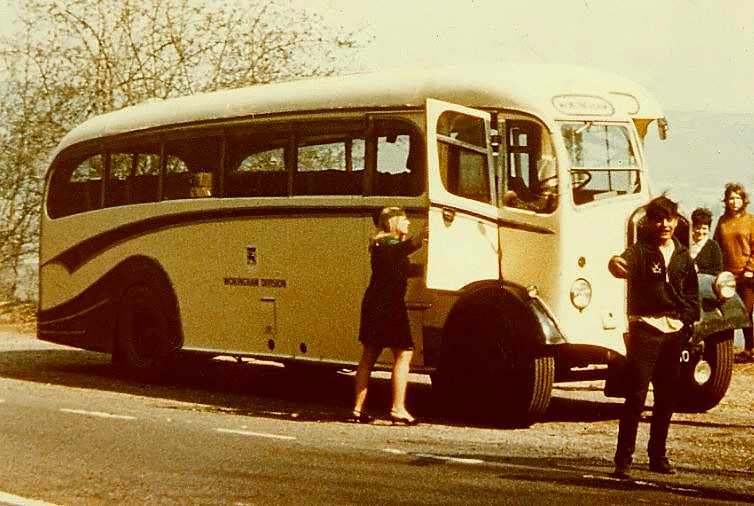
Keith Nicholson kindly sent me this picture in February 2015. It shows 1950 Dennis Lancet FBO 350 while working for the Wokingham Young Conservatives, Berkshire. Keith says: "I bought the coach in the late 1960s from Wokingham St. John's Ambulance, I think for £50. Where the photo was taken I can't remember, but I used the bus for group outings. I sold it to a bus preservation group but I can't remember their name or location, perhaps in the West Country?"
"It needed no mechanical work but sometimes to get it going I had to put a paraffin-soaked rag in the intake and set fire to it. The only problem I had was Wokingham police who stopped me every time they saw me out in the bus, and told me they would until I got a PSV licence. Smith's coaches in Reading kindly put me through the test and the police never stopped me again."
Keith also says he was told that the coach had an unusual body, and it did - Davies C33F. There weren't many Davies bodies on Dennis Lancets, and almost all were for Welsh customers (including five bus bodies for Merthyr Tydfil. Three of the Davies bodies were for E.R.Forse, Cardiff, including this one, FBO 350 in April 1950, along with FBO 850 and FBO 975 also during the summer of 1950. Forse were later bought by Western Welsh and this coach became their No. 590.
Many thanks to Keith for the photo and information. The coach did indeed survive into preservation, but ended up being scrapped in 2005.
A COUPLE OF MEMORIES FROM THE PAST
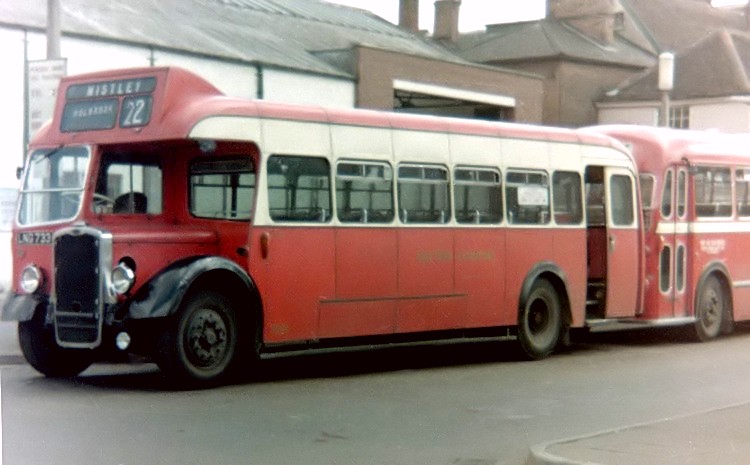
Robert Blackshaw kindly sent me these two pictures in March 2014. The one above was, he says, " taken at Ipswich when the Eastern Counties garage and bus station were in the centre of the town". It shows 1951 Eastern Counties LL733, a Bristol LWL5G (LNG 733) in 1965 outside Ipswich garage, serving on Route 22 south to Mistley, near Manningtree in Essex, via Holbrook. Similar but narrower bus LL718 (KNG 718) from 1950 still survives with the Eastern Transport Collection, but none of the 8ft wide 1951 'LNG' delivery is still with us.
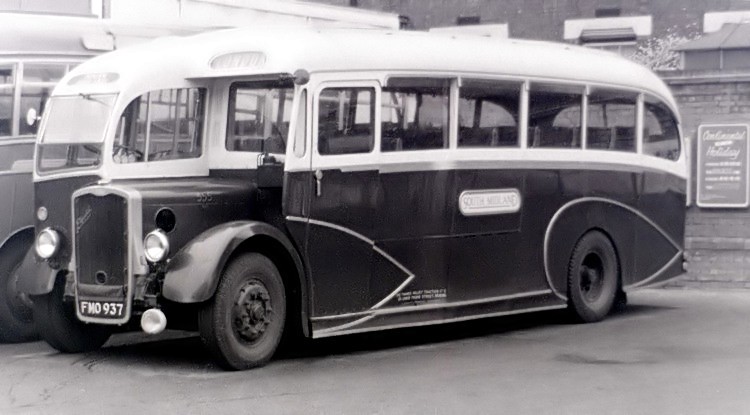
The second picture is at Victoria Coach Station in 1959. Robert says it is a "South Midland coach waiting at the back of Victoria for a late afternoon departure to Oxford". It's a 1950 Bristol L6B, South Midland No. 555 (FMO 937) with a Windover Huntingdon body. It was retired in 1962 and sold to Creamline, Bordon. My thanks to Robert for sending the delightful pictures.
RARE FREELINE PROJECT
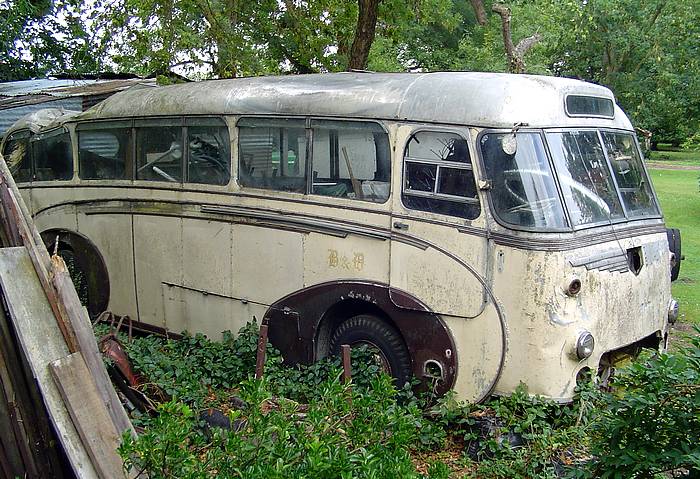
This sole surviving attendee of the first UK Coach Rally still survives in Cambridgeshire - or at least it did in 2013. It's NVE 1, a Daimler Freeline / Willowbrook C41C that was new to Burwell & District Motor Services in March 1955 after being exhibited at the 1954 Earls Court Commercial Motor Show.
The following year, 1955, it was entered in the first UK Coach Rally held at Clacton. It was withdrawn from service in March 1971, running units removed, and sold to one of B and D's drivers in 1974, who still has it today. Although it has been standing in the open for almost 40 years the frame work (apart from rear roof which was damaged by a falling tree) is remarkably sound.
The coach was available for preservation, although the number NVE 1 had been sold off the coach some years ago and at the time of writing was being offered by a number plate dealer for £18,995! The replacement number was ATW 528A.
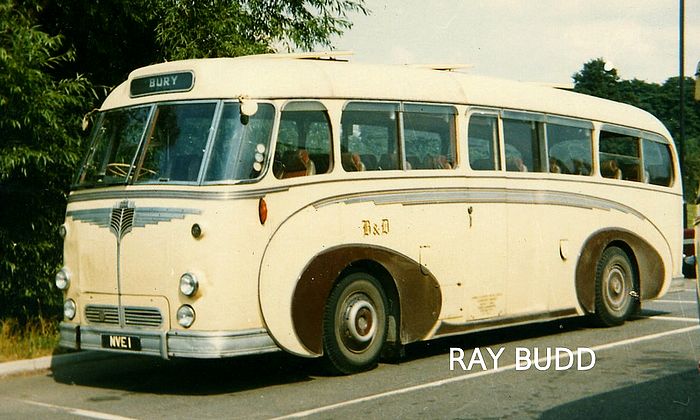
The photo above shows NVE 1 at Bury St Edmunds in the 1960s, and is shown by courtesy of Ray Budd. The top (2013) photo and information for this item was kindly submitted by John Wakefield.
BRIGHTON BELLE RETURNS TO SUSSEX
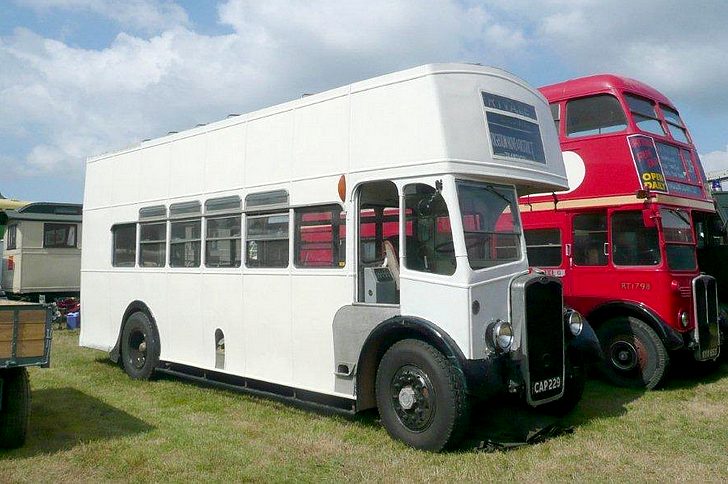
Over the 2013 August Bank Holiday weekend both Chris Stanley and I attended the thoroughly entertaining Hellingly Festival of Transport in East Sussex. The difference between us was that Chris remembered his camera, and I forgot mine. As a result Chris was able to take these pictures of the star exhibit at the show, in my opinion.
CAP 229 was one of a batch of Bristol K5G double deckers delivered to Brighton Hove and District in 1940. It was originally numbered 6352 but became merely 352 in the mid 1950s when it was upgraded and converted to convertible/open top for seafront route 17. Its red and white livery changed to all-white, as was usual at resorts around the country. The removeable roofs enabled the bus to be used throughout the year, an attribute that many open-toppers lacked.
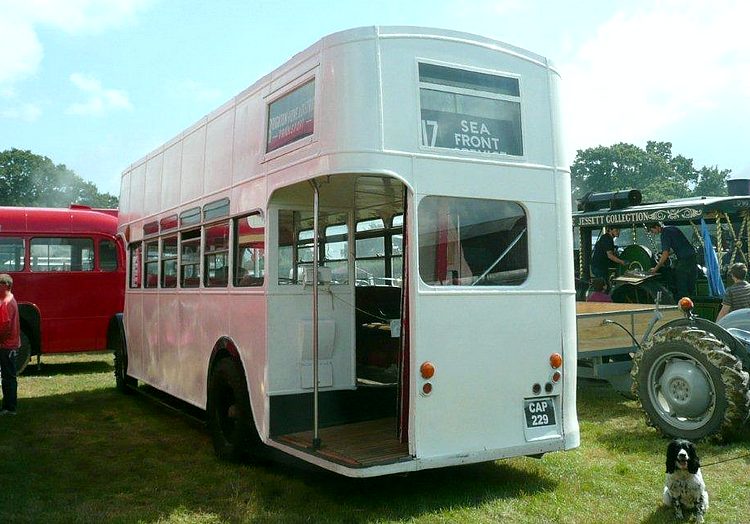
352 was sold to Eastern Counties in 1962, where it remained for six years. After that it went to renowned dealer Ben Jordan, passing to a preservationist in Suffolk in 1975, and then to another owner in Northampton who started a long-term restoration. Around this time the removeable roof acquired a pair of large 'roof light' windows in the front dome. What that was all about I have no idea, but I'll try to find out.
And then in March 2012 it was generously donated to the Claude Jessett Trust, partly because the owner felt that the restoration needed greater attention, and also because he felt it was appropriate that it should return to Sussex. Now resident at Tinkers Park, Hadlow Down, it has become a close neighbour of mine. The bus is back on the road (it hadn't been seen out and about for many years) and the work is progressing well.
Thanks to the team at Tinkers Park for bringing it to the show, and thanks to Chris Stanley for the photos.
ANOTHER LONDON RT LIVES (JUST ABOUT!)
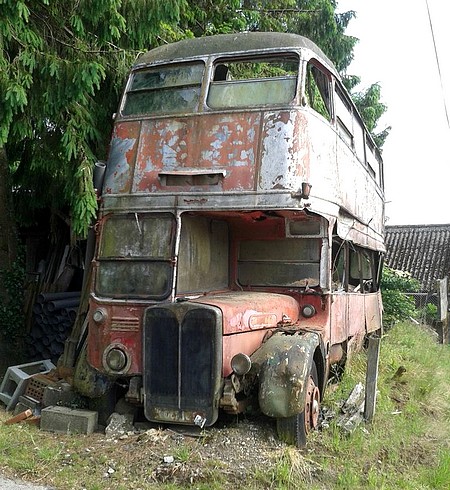
Stuart Hill kindly sent me these pictures. He took them on 24 June 2013 on a farm in the French Mayenne region near Caen. They show RT2180 (KGU 109) in a rather sorry state.
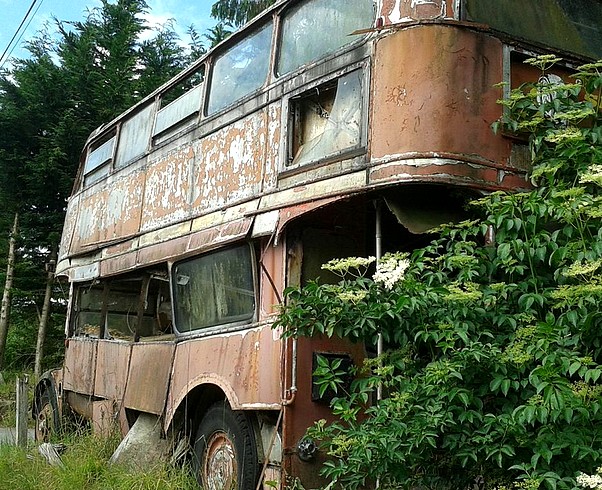
The bus was built in 1949, retired in 1972 and sold to a French promotion company, so it will soon have been in France for twice the time it was in service in London! I guess it's probably now well past any thoughts of restoration. Many thanks to Stuart for sending the pictures.
LONDON CUB MAKES PUBLIC DEBUT
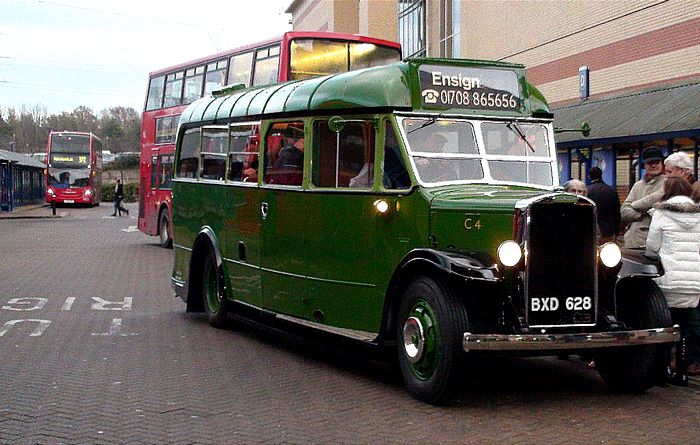
John Perthen very kindly sent me the photo above, taken on 1 December 2012 during the Ensignbus special Christmas services, involving classic buses running around Brentwood, Gravesend, Lakeside and nearby points. The surprise of the day was that Ensign revealed their newly-restored London Transport Leyland Cub, C4.
Apparently they have owned this bus for some years, and John says that the restoration - both inside and out - is nothing short of incredible. The Ensign website describes it as a unique vehicle from a bygone age. Painstakingly restored by us to concourse standard over a four year period, C4 is a truly unique vehicle that is now available to hire. Finished in the condition it would have been delivered in back in the 1930s the vehicle exudes the elegance and slower pace of life in those times.
P align=justify>John apologises for the quality of the photo due to poor lighting conditions, but I reckon he's done very well. Many thanks to him for sending the picture, and the news.MAGNIFICENT CROSSLEY WAS A SCHOOL PROJECT
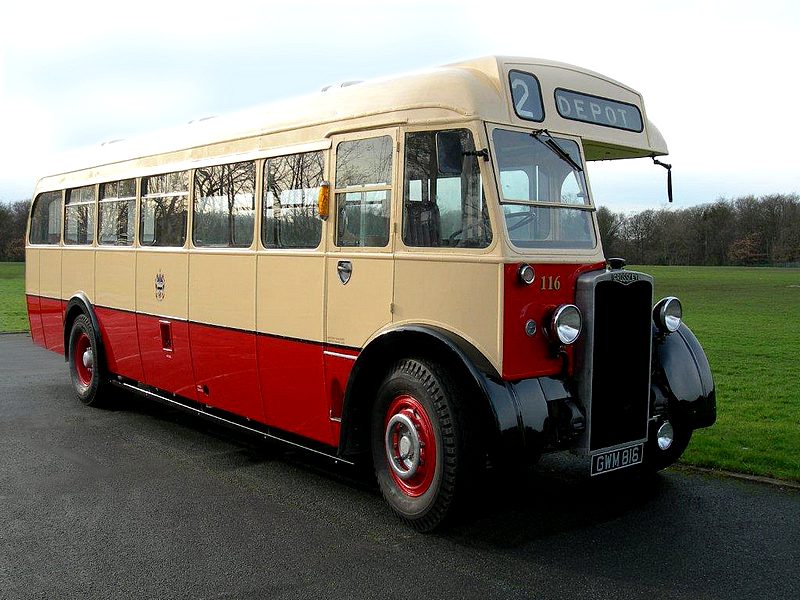
A ten year restoration project has been completed at last by staff and students at a Liverpool college, St Margaret's Church of England High School, using high performance coach enamels provided by HMG Paints of Manchester, No.1 coatings supplier to the UK bus and coach industry. There is a strong Manchester association, since the 60 year old bus was built by Manchester manufacturer Crossley, famed for the Mancunian buses that plied the city's streets from the 1930s.
There is also an interesting Christian association, since St Margaret's upholds all the principles that underpin a Christian school, while the Crossley brothers were themselves committed Christians, who refused to supply their vehicles to breweries and adopted the early Christian symbol of the Coptic cross as their bonnet emblem.
St Margaret's CE High School in Aigburth Road was established in 1879 and is now a dual specialist school, having been awarded both Technology and Language College status. It has run a Transport Society, or bus club, since 1971, to give students hands-on experience of structural and mechanical restoration. Its latest project is a Southport Corporation 1951 Crossley SD42/7, although previously it restored a 1949 Leyland Tiger PS1 coach, CMS 201.
The school is registered with the National Association of Road Transport Museums and, over the years, has received technical help from Manchester's Museum of Transport. So Deputy Headmaster John Wilkinson, who runs the bus club, approached the Collyhurst coatings company for support back in 1999. Since then it has supplied more than 100 litres of refinishing products at highly preferential rates, welcoming the opportunity to showcase the important preservation and decorative functions of paint.
John Wilkinson, who has a long-term interest in buses and coaches, found the dilapidated Crossley bus mouldering in a field in Chesterfield and, having first offered it to a county museum, the school decided to undertake the restoration itself, starting in 2002. The fortnightly Transport Society originally worked on old cars and motor cycles, but John found that buses offered far more scope for students to get involved, typically involving a dozen or so each session. He also has the expert help of Senior Caretaker, Campbell Dean, a time-served coach painter, and the school's Design Technician, Peter Pendleton, who reconstructed all the bus' internal woodwork, from templates produced by students.
Having stripped out the seating and interior components down to the composite framework, the bus club produced new aluminium body panels and sourced a genuine replacement bonnet and engine cover from a fellow enthusiast in Oldham. The final paintwork itself took a total of nine months to apply, employing two full coats of undercoat and three of gloss topcoat. In addition to traditional Coach Enamel for detailed work, HMG supplied DG142 Synthetic High Quality Primer/ Undercoat and SAH300 Polyurethane Enamel for the larger panels, both of which were originally developed for leading bus operator Stagecoach and together produce an unbeatable, high gloss finish.
These products are especially formulated for brush application, with a long wet edge time and no bristle drag, and according to John Wilkinson enabled an outstanding handpainted finish: "Campbell achieved a superb gloss appearance and if you can see any brush marks, I'll give you a sticky bun," he says. "We've since taken the vehicle to the MOT testing depot, where people are used to seeing modern buses, and they have been amazed by the standard of the paintwork. When he was a professional coach painter, Campbell used to swear by a traditional brushing topcoat that's no longer readily available, but now he insists that the HMG system is even better."
The school's Crossley SD42, one of a range of models built between 1947 and 1952, is finished in the Southport Corporation livery of ayres red and ivory. The 1949 Leyland Tiger single deck coach is painted azure blue and cream, also in HMG paints, and together these classic vehicles present a memory-provoking nostalgic sight.
BRISTOLS IN MACAU
My ever faithful correspondent Vic Brumby has sent some intriguing pictures from his remarkable archive of unusual buses - or buses in unusual places. This time we travel back in time to 1977, and across the world to what was then the Portuguese colony of Macau.
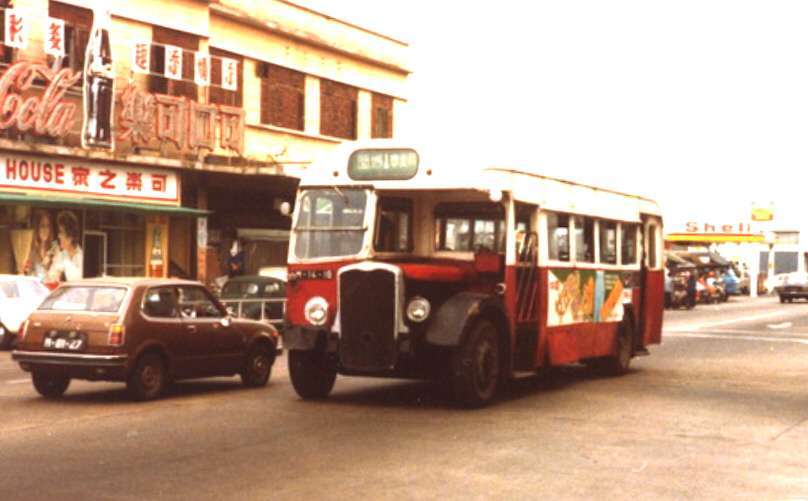
This looks to be an 'off the shelf' ECW-bodied dual-entrance Bristol L5G at first sight. I have what purports to be a list of the entire Bristol L production run, and it doesn't mention anything about Macau. So can someone throw some light of this? The registration number would seem to be M-14-18. And there's more....
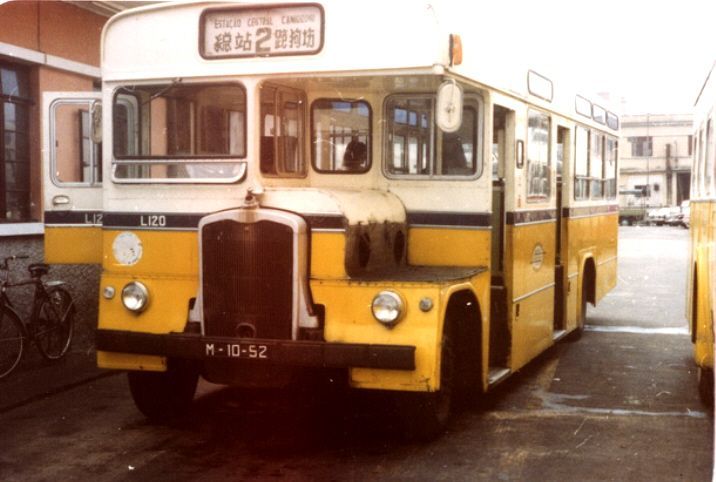
M-10-52 would appear to be a Bristol stablemate, but with a very different (and presumably locally-built) body; and finally Vic took a picture of a third example - clearly one that has it's finest days behind it.
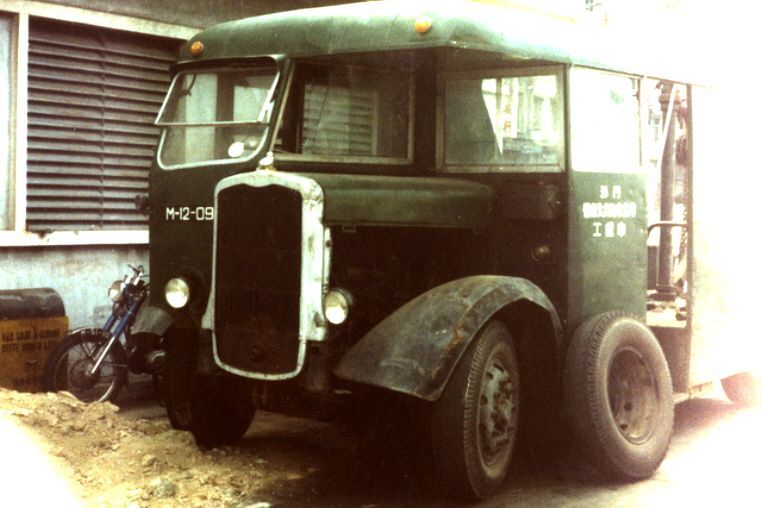
M-12-09 seems to have been converted into some kind of service vehicle. Anyway I'm sure it won't be long before someone writes in with details of the Macau Bristols. I look forward to hearing from them, and my thanks to Vic for yet more magnificent photos.
Well it didn't take long for my Irish friend Shane Conway to give us the clues. He said:
"Just seen the Macau pics - I think they are ex UK buses. There was an article in Buses Extra many years ago about Macau's buses. They also had Bristol Ks, some may have been ex Bristol Omnibus. The additional front doorway was a local alteration as far as I recall."
Then he quickly added:
"Just had a trawl through Gerry Tormey's
site:
They had 30 in total, all ex U.K. buses."
Well done Shane (and Gerry too!). Problem solved.
Terry Partridge sent me the definitive information in July 2012, based on records published in Mike Davis's book "Far East Buses - Volume 1, Macau, The British Bus Years". This lists all 30 of the Bristol L5G imports, the earliest being two 1939 examples from West Yorkshire (imported in 1956), and the latest were two from United Auto dating from 1950 (imported in 1966).
Other sources of these buses included Southern and Western National, Bristol Tramways, Eastern Counties, and Eastern Counties via Lincolnshire Road Car. Thanks very much to Terry for that interesting list.
'MOLLIE ON TOUR' IN 1954
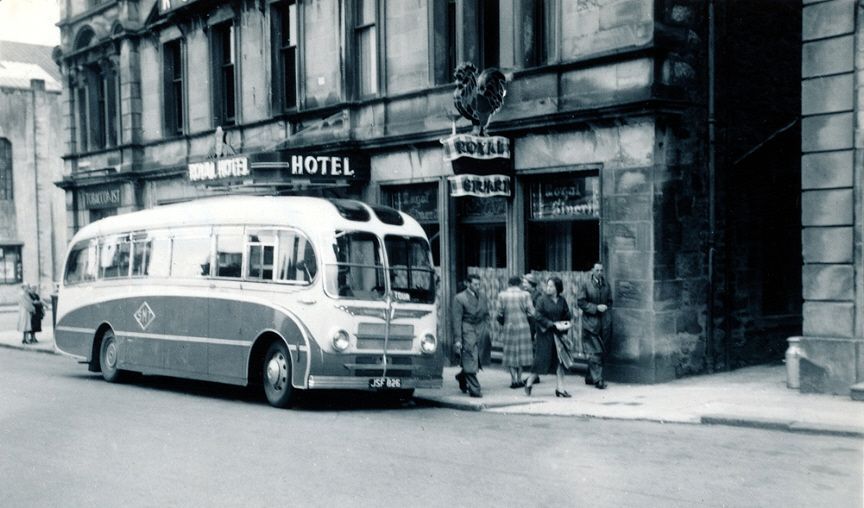
Graeme Fernie from Sydney, Australia has very kindly sent me these delightful pictures of coaches on tour. They were taken in 1954 by Mollie Thomas (1908-2008) during a trip she made to the UK and Europe that year.
Mollie gave the above image the caption Oban, West Scotland. Maybe it was taken on her way north up the west coast. The Royal Hotel in Oban is still there. The coach is Scottish Omnibuses (SMT) C201 (JSF 826), which is a 1952 Bedford SB with a Burlingham Seagull body.
.jpg)
The second picture is titled morning tea stop on way to York, so clearly Mollie is about to bid Scotland farewell and head south in another Scottish Omnibuses coach (this time one of a 1953 batch of AEC Regal IVs with Alexander bodies, numbered B463-479, KSC 540-556), but not before apparently taking a cuppa at the Wedding Inn, Gretna Green.... or is she?
In fact the Gretna Green Wedding Inn is nowhere near Gretna Green! Now just called the Gretna Green, it is near Newton Aycliffe in County Durham.
Next we head way down to the south west of England, where a Southdown coach has brought Mollie to Padstow.
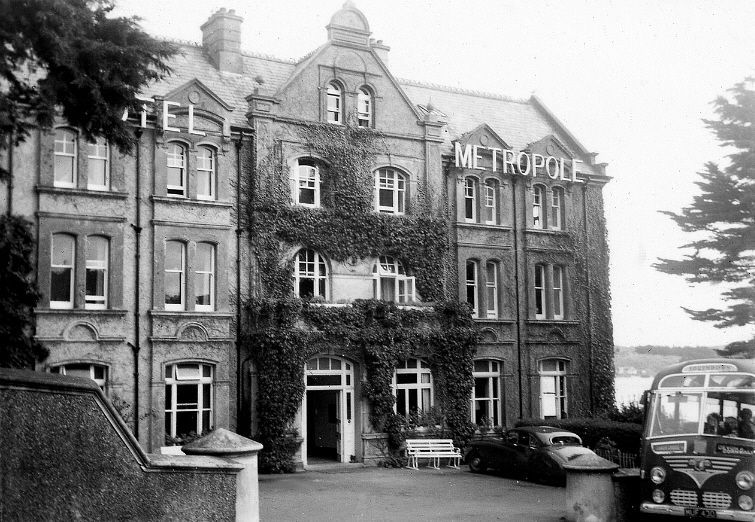
The Metropole Hotel in Padstow is also still there today. Meanwhile, hiding on the right is Southdown No. 830 (MUF 430), one of a pair of Leyland Royal Tigers with Harrington Wayfarer bodywork delivered in 1953. This was a luxurious 26-seat tourer with lots of legroom and a sliding sun-roof, so Mollie was travelling in style. The destination blind says Devon and Cornwall.
But Mollie had hardly started; the next stage of her tour was to take her across the Channel.
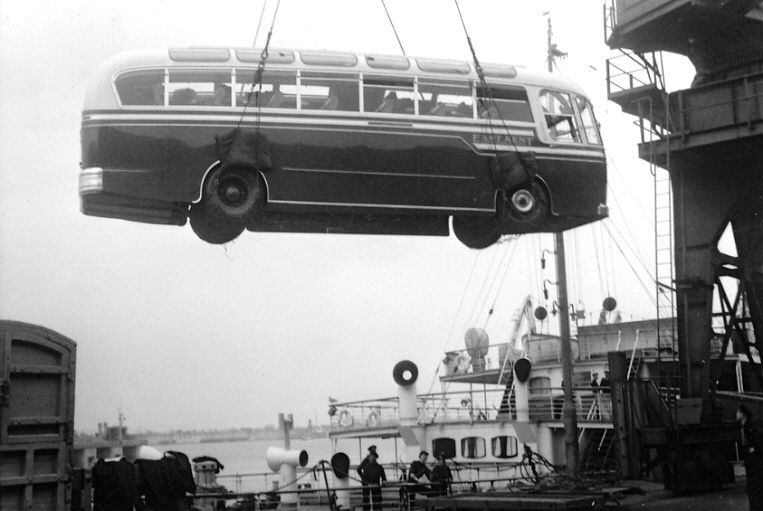
Here we see an East Kent underfloor-engined Dennis Lancet being loaded onto the cross-Channel ferry at Dover. All vehicles were traditionally loaded by crane there until 1953 (no roll-on roll-off ferries in those days!) when loading bridges were first introduced for cars. Presumably that luxury was not yet available for heavy vehicles in 1954.
Mollie seems to have travelled on this coach through France, Belgium, Germany, Austria, Italy, Monaco and Switzerland. The photo below is simply labelled Verona.
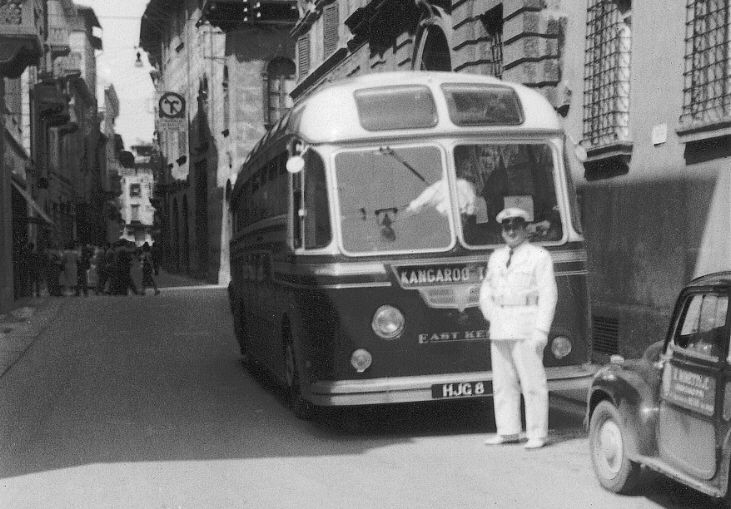
Now we can see that the coach is HJG 8, the sixth of a batch of 30 Dennis Lancets still being delivered brand new to East Kent when Mollie boarded it in 1954. Those first six Duple Ambassador bodies seated a spacious 32 passengers, while the rest of the delivery seated 41. Mollie was still travelling in great comfort!
I assume that's the East Kent driver in his smart summer uniform. As for Kangaroo Tours, well maybe someone can tell us more about them. It's certainly got nothing to do with the Australia/England rugby tours of the same name - there wasn't one in 1954.
Allan Haynes adds more to this: "The nose-on picture of HJG 8 in Verona - that is very definitely not the EK driver standing in front of it! They did not issue white suits, even for tours to warmer parts. And his 3" wide webbing belt... He is an official of some sort, possibly a Carbiniero, and seems to have taken command of the parking of the Dennis. The actual driver is the bloke inside in rolled-up shirt sleeves aiming for the back of the coach. East Kent summer uniform I think I remember involved the same navy serge trousers as the rest of the year, and a grey dust jacket with red trimings. I did have two uncles who drove for EK, but it was a long time ago...."
Thanks to Allan for that, and many thanks to Graeme for passing on these interesting photographs.
DERELICT DENNIS
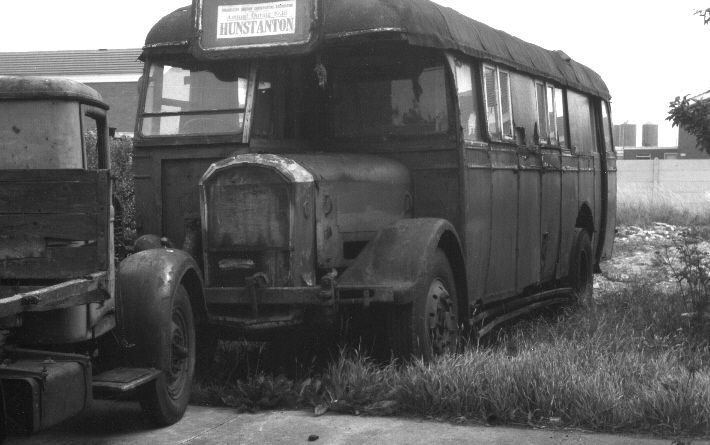
Nigel Lemon said "One summer evening in 1970, probably July, I saw this vehicle on tow behind a lorry passing westbound along the A41, little more than a mile before the centre of Chester: this was in the days before the Chester by-pass, and I would liked to have seen how this convoy negotiated the centre of the city! Anyway, a few days later I made a point of visiting Tom Hollis's yard at Queensferry (always an interesting place) to see if this had been its destination."
"My hunch proved correct, but although I had a few brief words with Tom Hollis, I feel sure that I didn't discover what the origin of the Dennis was. Forty years on leaves me wondering whether someone somewhere else might know more, both as to the origin of the bus and also its fate."
The destination box on this pre-war Dennis Lancet reads "Colchester Division Conservative Association, annual outing 1935, Hunstanton". Is that genuine? And what was the history of this bus?
As usual, there was no shortage of responses.
Owen Phillips thought it was likely to be an Eastern National bus from the mid-1930s with an Eastern Counties body, and I was inclined to agree. The 1934 AVW-registered batch looked just like this (apart from the absence of a rear roof luggage pannier). But it doesn't explain the trip to Hunstanton in 1935.
But then John Wakefield got involved, and he contacted Geoff Mills who revealed the following: The bus is Eastern National Dennis Lancet 1/ECOC-bodied BTW 482, new in June 1935 as No. 3543 (chassis number 170797). It became a caravan in August 1951 at Wormingford, Essex occupied by a Mrs. Munson. When she died it was acquired by John Jackson (co-owner today of a Sunderland Crossley), and it was probably John who put the Hunstanton notice on the front - he being a staunch Conservative.
On 26 April 1970 it was towed to Tom Hollis's yard at Queensferry, and that must have been when Nigel spotted it. From there it went to Plumtree, Notts, where a group of enthusiasts intended to restore and exhibit it. Unfortunately the project failed and the bus was subsequently scrapped.
So that's the story. Many thanks to John and Geoff for the information.
ANOTHER DERELICT DENNIS
.jpg)
Derek Wilkinson purchased this image in 2011 at a transport museum, but couldn't identify it. No registration number is visible. John Bennett initially said he thought it was a Dennis EV, of which not very many were built. The EV was basically a 1929 facelift of the Dennis E. John later added this further comment; "I am advised that this is one of the West Bromwich Dennis EVs with a body by W J Smith. They were EA 4371 to 4373 and 4727/8."
Another mystery solved, by the sound of it. If anyone has more information about it, do let me know.
NEWLY RESTORED RAMBLER BEDFORD
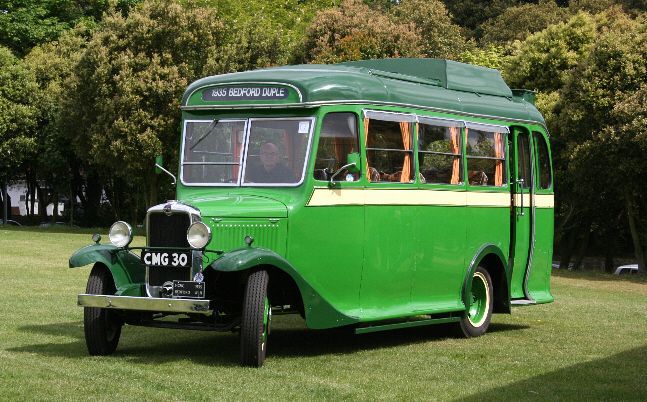
Terry Blackman kindly sent this picture. He explains that the glorious coach is Rambler of Hastings 1935 Bedford WLB with Duple body, making its first appearance since restoration at the Hastings Trolleybus Restoration Group's 19th annual classic vehicle rally at the Oval, Hastings on 15 May 2011. It has gradually been restored since acquisition in late 2008".
CMG 30 was delivered new to Garner's Coaches of Ealing. After military service during the war, it passed to a Devon owner, and has been in preservation for many years. In fact, after a previous restoration process by a Surrey owner, it won 2nd prize in its concours class at the HCVC London-Brighton run in May 1967, and the Ian Allan trophy the following year. So it's no stranger to the rally business, but a wonderful sight nonetheless. Many thanks to Terry for the photo.
John Wakefield kindly added the following details about the vehicle: Chassis No 110051, Body No 5401, 6/35 new to Garner, Ealing, 6/43 Edward Saunders, Winkleigh (re-reg JTA 608). By 1964 it was with Burt and Mitchell, Exeter (preservation), 4/66 E. J. Baker Motors Ltd., Bordon, 10/66 Eric Taylor Tintinhull (reg. reverted to CMG 30 5/67), -/91 Steven Taylor, Tintinhull on death of Eric Taylor in 1991, 11/08 Colin Rowland (Rambler Coaches) Hastings.
ON HIRE TO ROYAL BLUE
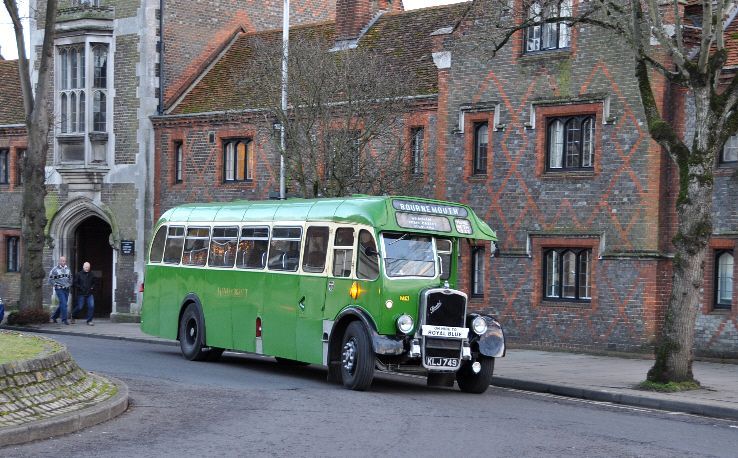
This was a Star Picture on the homepage at the beginning of 2011, but it deserves to be preserved permanently, so here it is. Ken Jones went to Winchester on 2nd January 2011 for the King Alfred Running Day, and took this fine picture of KLJ 749, apparently on hire to Royal Blue. Hants and Dorset 779, a 1950 Bristol LL6G with a Portsmouth Aviation body, is seen negotiating the roundabout at the end of the Broadway in Winchester, and is currently preserved by owners in Bristol. Many thanks to Ken for the photo.
CITY COACH MEMORIES
Dennis Coote contacted me in November 2010 to chat about the City Coach Company which operated in south Essex. He spent his schooldays travelling on their buses, a fleet which incorporated a very wide variety of interesting vehicles, ranging from 1939 Leyland Gnus, and 3-axle Tigers to post-war Titans, including LEV 917 which is preserved in the U.K. (A history of that bus can be found here).
Formed in 1923 as a pirate operator, the firm is best remembered for its Wood Green to Southend service. City Coach sold out to the British Transport Commission in 1952, and Westcliff-on-Sea Motor Services acquired all their vehicles. Eastern National then took over Westcliff later that year.
Dennis took some photos of their buses around 1947, and has kindly sent them to me. Even he would admit that the quality is not great, but the content is rare and fascinating, so here they are.
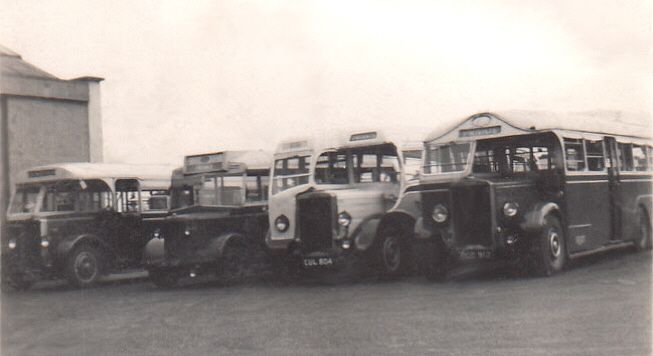
Dennis recalls his school days travelling from Laindon to Brentwood on these wonderful buses (my mother always referred to the buses as 'Old Toms', no idea why). My favourite was a Leyland Tiger DUC 912, fleet number LT12. One of my fellow passengers was Joan Sims, the Carry-On star, whose father was the stationmaster at Laindon Station. On the right in the above picture is that very bus - DUC 912, a fabulous 3-axle Tiger TS7T from 1937. The body, I think, is by Beadle. Next to it is LT10 (CUL 804), another six-wheel Tiger TS7T, new in 1936 and wearing a Heaver body fitted in 1947. Then we see what looks like one of the Bedford OB / Mulliner buses delivered in 1946 and, on the left, another pre-war Tiger.
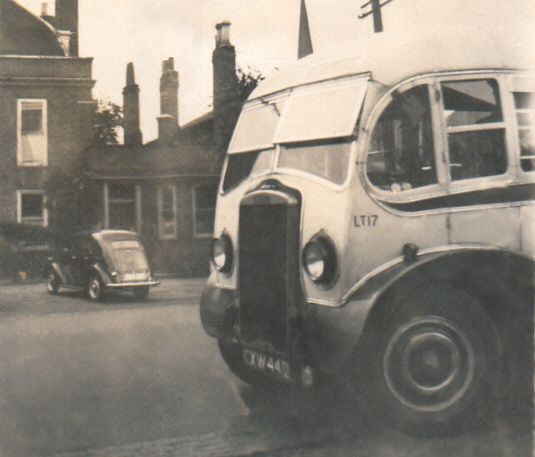
Photographed by Dennis in Brentwood around 1947 is number LT17 (CXW 442), a full-fronted pre-war Leyland Tiger.
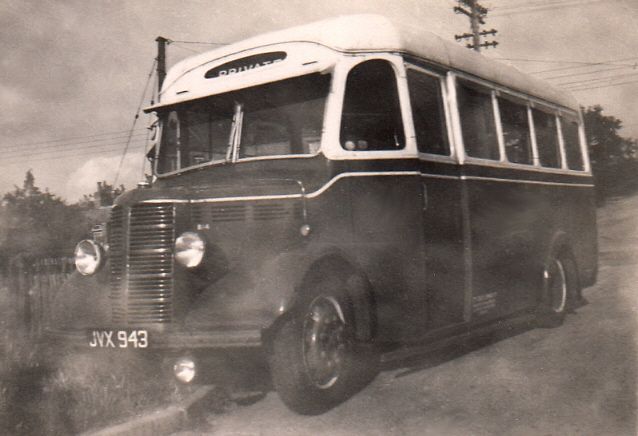
Finally here is Bedford number B14 (JVX 943).
Apart from LEV 917, the only other known City Coach survivor (unless you know better!) is Leyland Titan NVX 311, which is rumoured to exist in the USA. It was reportedly last seen in North Carolina in 2007. There's a picture on this page http://www.historicbeaufort.com/ which apparently shows the bus, and dates from 2000 or earlier, but that particular tour has now been taken over by an open top Routemaster.
Many thanks to Dennis for these unusual photos, and the oppportunity to remember a charismatic operator from the past. If anyone can add more detail to these images I would be delighted to hear from them.
LISBON REGENTS
Robert Lanham contacted me in May 2010 to say that he and a group of colleagues interested in British bus exports had arranged a trip around Lisbon, Portugal in the Carris Museum's beautifully restored AEC Regent No.217 - apparently a very rare occurrence. Here is a picture of Carris 217 taken by Robert in Lisbon in 1981 (it is currently displayed in an earlier livery and configuration).

Robert also sent a picture of its stablemate No.255, now registered KSV 102 here in the UK and seen below next to Ipswich Regent No.1 on the promenade at Felixstowe during a road run on 2 May 2010. Mirror image halfcabs take some getting used to - the drivers are shaking hands through the cab windows!

As far as is known, only these two Carris Regent IIIs survive (217 from 1952, and 255 from 1954, both with Weymann bodies) and two Regent Vs (301 from 1957, and 426 from 1961). Four Carris single deck Regal IIIs from 1948 are also preserved - three of them in the UK. Carris has been the major public transport facility in Lisbon for over a century, and their Museum has a website here.
Many thanks to Robert for sending the interesting photos.
KENYAN GUY ARAB
Here's another fascinating image from the archive of my faithful correspondent, Vic Brumby:

It's Kenya Bus Services No.152, seen in a Kenyan field in 1973. Vic says "it's probably down to the diff by now." No.152 was a Guy Arab IV with a Park Royal 70-seat body, delivered to Nairobi in December 1956 with local registration number KFJ 176. About 20 were bought during 1955-57 for service in Mombasa and Nairobi, and Uganda had similar examples too. The speed limitation was reputedly 25 mph.
Not a sight you see every day, and I just love the picture. Many thanks Vic.
CHELTENHAM DISTRICT TRACTION PICTURES
Deryck Hudleston kindly sent me these pictures from a book he recently acquired about the buses of Cheltenham District Traction Co (Deryck's old home town), a company not often mentioned. The book concerned was Cheltenham's Trams and Buses by John B Appleby, and was published several decades ago. Sadly the author is no longer with us, but Deryck obtained permission from John Senior of MDS Book Sales to reproduce these images. Because they are copied from a book, the quality isn't outstanding, but the rarity of the pictures convinced me to publish them here.
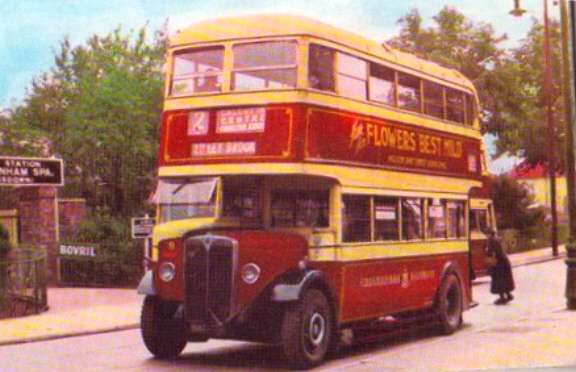
The first picture above shows 1930s AEC Regent I No.9 with a well-proportioned Weymann body.
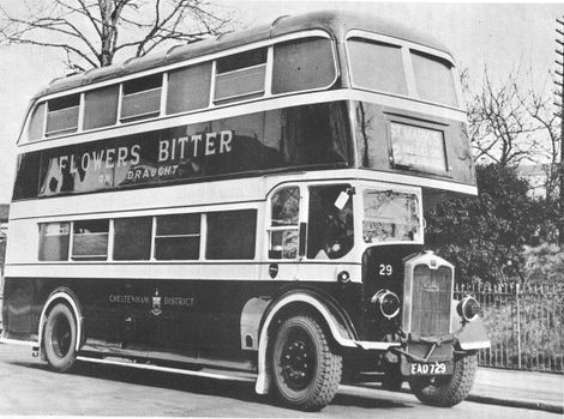
Next we have Albion CX19G Venturer No.29 (EAD 729). This was the first of five delivered in 1940 (29-33, EAD 729-733) with very traditional Weymann provincial bodywork. The CX19 G version had a Gardner 6LW engine instead of an Albion unit. These buses were Cheltenham's first Albions, but not their last, as we can see below.
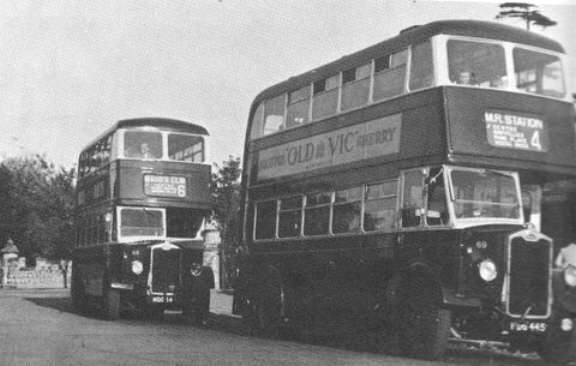
Two more Albions from the post-war examples are shown above, led by No.69. The town's second, and last, Albion delivery came in 1949 when it took six more CX19 Venturers, 68-73 (HDG 444-448 and FCY 763) with Metro-Cammell bodies. One of these - No.72 - survives (see below).
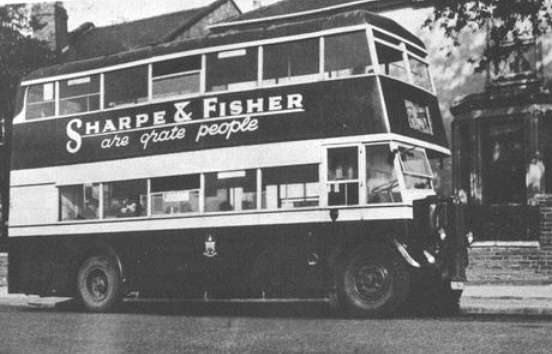
Finally here is a utility lowbridge Guy Arab. I'm not sure which one it is, but it seems the company acquired Arab mk.1 nos. 40-48 (EDG 968-976) in 1943, variously bodied by Strachans, Northern Counties or Duple, Arab mk.II nos. 49-52 (FAD 250-253) bodied by Park Royal in 1944, and nos.55-59 (FAD 831-835) with Strachans bodies in 1944, so I guess it's one of all those.
There are some survivors from this fleet, including 1949 Albion Venturer No.72 (HDG 448) which is fully restored at the Transport Museum, Wythall, and 1961 Bristol FSF6G Lodekka 802 MHW. The company, formed in 1929 and acquired by Red and White in 1939, lives on as part of the Stagecoach group. Many thanks to Deryck for sending me these images, and thanks also to MDS Book Sales for permitting their reproduction.
See more archived news and pictures on Page 1 (latest) or Page 3 (older).
Want to see some more? Have a look at all the other profiles on the Classic Buses menu page.
SOME LINKS WITHIN THIS WEBSITE: Home Email Links THE COMPLETE WEBSITE MENU Events Diary Halfcab list Small-Ads Classic Irish Buses Classic Manx Buses